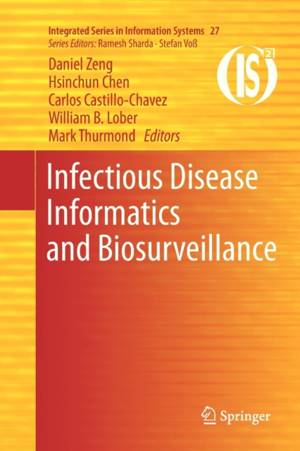
- Retrait gratuit dans votre magasin Club
- 7.000.000 titres dans notre catalogue
- Payer en toute sécurité
- Toujours un magasin près de chez vous
- Retrait gratuit dans votre magasin Club
- 7.000.000 titres dans notre catalogue
- Payer en toute sécurité
- Toujours un magasin près de chez vous
Infectious Disease Informatics and Biosurveillance
307,45 €
+ 614 points
Description
This book on Infectious Disease Informatics (IDI) and biosurveillance is intended to provide an integrated view of the current state of the art, identify technical and policy challenges and opportunities, and promote cross-disciplinary research that takes advantage of novel methodology and what we have learned from innovative applications. This book also fills a systemic gap in the literature by emphasizing informatics driven perspectives (e.g., information system design, data standards, computational aspects of biosurveillance algorithms, and system evaluation). Finally, this book attempts to reach policy makers and practitioners through the clear and effective communication of recent research findings in the context of case studies in IDI and biosurveillance, providing "hands-on" in-depth opportunities to practitioners to increase their understanding of value, applicability, and limitations of technical solutions. This book collects the state of the art research and modern perspectives of distinguished individuals and research groups on cutting-edge IDI technical and policy research and its application in biosurveillance. The contributed chapters are grouped into three units. Unit I provides an overview of recent biosurveillance research while highlighting the relevant legal and policy structures in the context of IDI and biosurveillance ongoing activities. It also identifies IDI data sources while addressing information collection, sharing, and dissemination issues as well as ethical considerations. Unit II contains survey chapters on the types of surveillance methods used to analyze IDI data in the context of public health and bioterrorism. Specific computational techniques covered include: text mining, time series analysis, multiple data streams methods, ensembles of surveillance methods, spatial analysis and visualization, social network analysis, and agent-based simulation. Unit III examines IT and decision support for public health event responseand bio-defense. Practical lessons learned in developing public health and biosurveillance systems, technology adoption, and syndromic surveillance for large events are discussed. The goal of this book is to provide an understandable interdisciplinary IDI and biosurveillance reference either used as a standalone textbook or reference for students, researchers, and practitioners in public health, veterinary medicine, biostatistics, information systems, computer science, and public administration and policy.
Spécifications
Parties prenantes
- Editeur:
Contenu
- Nombre de pages :
- 488
- Langue:
- Anglais
- Collection :
- Tome:
- n° 27
Caractéristiques
- EAN:
- 9781461427643
- Date de parution :
- 27-12-12
- Format:
- Livre broché
- Format numérique:
- Trade paperback (VS)
- Dimensions :
- 156 mm x 234 mm
- Poids :
- 748 g






